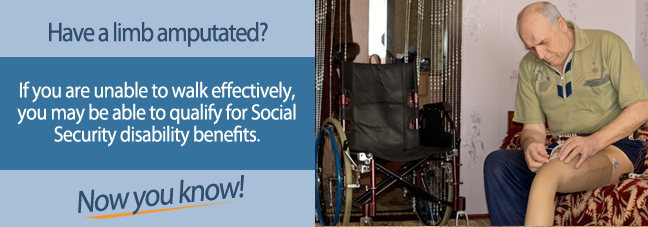Whether due to an accident or complications from disease, an amputation changes everything. It will require adjustments in your personal life and routine activities and may have a profound effect on employment as well.
Some amputees are able to continue working, with minimal accommodations. For others however, the loss of a hand, foot, or limb may stop them from performing essential job duties, leading to a loss of employment and income.
If you’ve undergone amputation surgery and are no longer able to work, then you may qualify for Social Security disability. Benefits from the Social Security Administration (SSA) provide income you can count on each month and ensure you have the financial stability to pay rent, bills, and cover everyday costs, like food, clothing, and transportation.
Medically Qualifying through the Blue Book
The SSA maintains a manual of disabling conditions, which is known as the Blue Book. This manual is used by disability examiners when they review applications for benefits. Each listed condition outlines the severity level necessary and the medical evidence required for an applicant to be considered disabled and therefore eligible for benefits.
Amputation appears in Section 1.05 of the Blue Book. To qualify under this listing, you must have lost:
- Both hands
OR
- One or both legs and be unable to walk, even with a prosthetic, due to stump complications
OR
- One hand and one leg, with an inability to walk, even with a prosthetic limb
Amputations that result in the removal of part or all of the pelvis, hip, or hips, also “automatically” meet medical eligibility requirements under the listing in Section 1.05.
Although you’re considered eligible for benefits if you meet any portion of this disability listing, you must still complete the full application process and back up your claim with appropriate medical evidence. With an amputation, minimal medical records are typically necessary for approval, but usually include surgical notes, post-operative evaluation and treatment records, and documentation of any complications.
Qualifying without Meeting the Amputation Disability Listing
When an amputee doesn’t meet the disability listing, the SSA looks at his or her daily limitations through a process known as a residual functional capacity evaluation or RFC. You’ll complete additional questionnaires and your doctor will be asked to do the same. These questionnaires look more closely at how your amputation affects your everyday abilities, including the performance various tasks in your personal life.
The SSA compares your functional limitations with the requirements of typical job duties. They additionally look at your medical records again as well as your age, education level, job training, and work experience. After taking all of these factors under consideration, the SSA may approve you for disability, if you cannot reasonably be expected to get and keep a “substantial” job in which you’re able to earn a gainful living.
Getting Help with Your Claim
You can seek assistance from a disability advocate or attorney when applying for disability. This is particularly advisable if you’re unable to meet the SSA’s disability listing requirements, as you are more likely to be denied benefits and need to go through additional eligibility reviews.
An attorney or advocate can assist you with your application and the collection of medical records and other proof of disability. He or she can additionally help with filing an appeal and preparing for the appeal hearing, if you’re initially denied benefits.
